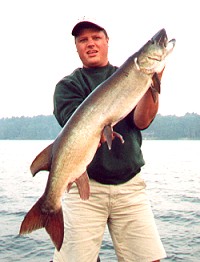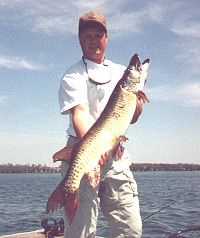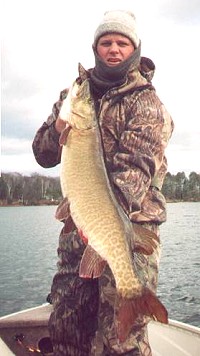A question of clarity
As Appeared in the December 200/January 2001 Issue of Musky Hunter Magazine
By Jason Long
Not all musky lakes are the same. Some are big, small, deep, shallow, remote, metropolitan, weedy, rocky?.. Well, you get the point. Regardless of the hundreds of different characteristics any given musky lake may possess, they all have one thing in commom?.. water.
Although all lakes, rivers, reservoirs, etc. are created by water, the characteristics of the water can drastically differ between them. One important characteristic that all musky hunters should consider before placing their first cast is water clarity. Several factors contributing to water clarity can significantly influence the best time of year to fish a lake, what locations within the system will consistently hold muskies, and what style and color lures are most effective.
WATER CLARITY CLASSIFICATION
 The single most important way to differentiate each body of water you intend to hunt muskies is to classify them as clear or stained based on their permanent water coloration. Stained lakes have a brown, transparent tint caused by either dissolved tannic acid or iron. Tannic acid is produced from decaying wood and iron is dissolved from rocks. The most common source of tannic acid is nearby swamps or bogs. Typically, stained lakes can range in color from something resembling black coffee to that of a light tea. A heavy stain may limit visibility to one or two feet, whereas a light stain may allow you to see bottom in as much as seven or eight feet on a bright, sunny day. Some people will even observe the color of their prop wash to determine the presence of a stain. Generally speaking, stained lakes are most prevalent in densely forested areas such as northern Wisconsin or shield rock regions.
The single most important way to differentiate each body of water you intend to hunt muskies is to classify them as clear or stained based on their permanent water coloration. Stained lakes have a brown, transparent tint caused by either dissolved tannic acid or iron. Tannic acid is produced from decaying wood and iron is dissolved from rocks. The most common source of tannic acid is nearby swamps or bogs. Typically, stained lakes can range in color from something resembling black coffee to that of a light tea. A heavy stain may limit visibility to one or two feet, whereas a light stain may allow you to see bottom in as much as seven or eight feet on a bright, sunny day. Some people will even observe the color of their prop wash to determine the presence of a stain. Generally speaking, stained lakes are most prevalent in densely forested areas such as northern Wisconsin or shield rock regions.
If a lake does not have the presence of a permanent stain, I consider it a clear water lake. Generally speaking, visibility in clear lakes can range from 8 to as much as 20 or more feet, depending on the fertility of the water. Water fertility is basically the amount of dissolved nutrients such as phosphates, nitrates, etc. that are available as food for microorganisms and phytoplankton. Infertile lakes, those with very little dissolved nutrients, are typically the most clear and have the most stable water clarity.
After I have classified a lake as either clear or stained, I determine if there are any environmental factors that may influence water clarity. Both clear and stained lakes can also become dirty or experience an Algae Bloom that may substantially alter water clarity. The key is to identify the source of light-blocking materials.
Dirty or turbid water is commonly a result of short-term weather conditions and the temporary suspension of silt, sand, and other inert solid materials. Heavy rains will often wash sediment into a water system, temporarily coloring the water. River systems, as well as reservoirs, may be more susceptible to short term sediment conditions due to increased run-off. Systems with current may have a more permanent dirty condition, however when the water flow subsides the sediment can settle and visibility is increased. I consider dirty water conditions something that resembles chocolate milk with visibility in inches rather than feet. It is possible to have a clear-water reservoir turn into a dirty water situation almost overnight.
The second environmental influence to water clarity is directly related to water fertility. Seasonal algae blooms develop on many popular musky waters. Algae blooms become more severe with increasing water fertility. Fortunately, algae blooms are fairly consistent and occur about the same time each year, since they are photosensitive and grow depending on light availability. I fish several lakes that are gin clear at the beginning of the season, but turn to pea soup after the long days of summer have allowed the algae plenty of time to grow. If the algae bloom is severe enough, the lake may not clear up before first ice. Typically speaking, an algae bloom will subside after the fall turnover, offering higher visibility water conditions again late in the season.
INFLUENCE ON MUSKY LOCATION
 Now that you are able to classify your favorite musky lakes based on both permanent coloration and environmental conditions, you need to know how to respond to such conditions in order to consistently locate and catch the elusive muskellunge. In my opinion, stained lakes provide the most consistent patterns and are more forgiving to the novice angler. Although stained lakes are excellent all year, they also provide an advantage during early season. The dark color absorbs the sun’s energy better than clear water, resulting in accelerated water temperatures in the spring. Since muskies spawn when water temps are in the mid to upper 50’s, stained lakes often produce the first good post-spawn bite.
Now that you are able to classify your favorite musky lakes based on both permanent coloration and environmental conditions, you need to know how to respond to such conditions in order to consistently locate and catch the elusive muskellunge. In my opinion, stained lakes provide the most consistent patterns and are more forgiving to the novice angler. Although stained lakes are excellent all year, they also provide an advantage during early season. The dark color absorbs the sun’s energy better than clear water, resulting in accelerated water temperatures in the spring. Since muskies spawn when water temps are in the mid to upper 50’s, stained lakes often produce the first good post-spawn bite.
Shallow water is your best choice to begin fishing a stained lake. The reduced light penetration offers some security to the fish, but it also limits weed development. Typically, the best sources of cover such as rocks, stumps, fallen trees, and weeds are more commonly found in shallow water. Start your search in these areas. Rocks offer the least amount of cover, however you?d be surprised how shallow a musky will hold on a rock structure, especially if larger boulders are present.
Not only do I favor stained lakes during the spring season, I also prefer to fish stained water after a major cold front. Muskies will often hold very close to cover, especially thick weedbeds, during cold front conditions. Considering that the weedline in heavily stained lakes may be as shallow as five feet or less, the opportunity to present a lure in the reduced strike zone of a cold-front shy musky is greatly enhanced. This is a great time to catch a trophy musky shallow while many musky hunters choose to stay home.
Clear lakes are the most fun to fish, but can also be the most frustrating. Traditionally, clear lakes are notorious for producing lots of follows with fewer strikes. This reputation has lead to the belief that clear lakes should only be fished under overcast conditions. Not true! I believe muskies in clear lakes are dominantly sight feeders, therefore the best conditions for these fish to feed should be under bright sunny skies. Believe me, you can catch fish in clear lakes under any light condition.
 Although clear lakes can be dynamite all season long, there are three opportunities I?d like to point out. The first occurs during early spring, just after the fish complete their spawning ritual. At this time, I select lakes that have abundant weed growth and target the newly emerging weedbeds. Muskies may be cruising the warm shallows, looking for an easy meal. Some of the best weedbeds to target are those that will become too thick to fish by midseason, but have not yet fully developed allowing you to easily fish them with a small bucktail or minnowbait. The advantage of this pattern is the opportunity to contact fish that spend the majority of their lives out in deep water, but are temporarily enjoying the warm, shallow cover and the concentrated food supply it attracts.
Although clear lakes can be dynamite all season long, there are three opportunities I?d like to point out. The first occurs during early spring, just after the fish complete their spawning ritual. At this time, I select lakes that have abundant weed growth and target the newly emerging weedbeds. Muskies may be cruising the warm shallows, looking for an easy meal. Some of the best weedbeds to target are those that will become too thick to fish by midseason, but have not yet fully developed allowing you to easily fish them with a small bucktail or minnowbait. The advantage of this pattern is the opportunity to contact fish that spend the majority of their lives out in deep water, but are temporarily enjoying the warm, shallow cover and the concentrated food supply it attracts.
The second opportunity occurs during early summer when the lakes begin to stratify. Infertile lakes typically have the clearest water and have very limited shallow water cover, therefore the majority of the musky population in these types of lakes suspend out over open water. Furthermore, muskies require lots of dissolved oxygen and are forced to spend the majority of their time above the thermocline. As the thermocline develops, it is typically as close to the surface it will be all season. In essence, the fish are trapped in a very narrow water column and are most vulnerable to casting methods. Now is the time to get on those stubborn gin bottle lakes and fish over the deep main-lake basins with shallow running presentations.
Another great opportunity develops on clear lakes late in the season. After the fall turnover, many of the open water forage move back towards more traditional shallow water structures and the muskies follow. The most talked about pattern relates to the late fall cisco or tullibee spawning migration. These popular cool water forage spawn on shallow sand and rock structures close to ice-up. This is a great pattern to exploit, however I have also discovered that lakes which do not contain cisco also experience a similar movement. One of my favorite clear water lakes does not contain cisco, but has a very healthy perch, bluegill, and crappie population. These panfish often suspend out over open water during the warm summer months feeding on phytoplankton, but the cool water of fall and the mixing process of turnover scatters their once concentrated food source. This forces the large schools of perch and crappies back to the more common shallow water structures, especially steep breaklines, where they can find other sources of food.
When weather or seasonal influences alter the water clarity, you must adjust your tactics accordingly. When dirty conditions prevail, typically my first response is to look for very shallow structure and cover. The suspended solid particles that are generating the turbid water conditions scatter and absorb lots of light. If there is any weed growth in the system, the only weeds still producing oxygen will be those situated shallow enough to still receive sufficient amounts of light for the photosynthesis process. Therefore, check the quality of the weedbeds before fishing them to determine whether the weeds are still alive and at what depth they begin to die off. Do not focus on the weedline if the weeds begin to die off at a shallower depth, but rather look for the pseudo weedline created between the living and dead plant life.
If the weeds are dead and decaying or the system rarely develops many weeds even under optimal conditions, look for wood or rock cover. When fishing the rocks, consider the fact that the turbid water itself can act as a source of cover. A large fish can feel fairly secure in a foot or two of water when visibility is limited to only a matter of inches. The larger the rocks and more vertical the structure, the better the spot.
Algae blooms provide similar circumstances as those experienced under dirty conditions. Algae blooms take time to develop and muskies generally do not need time to adapt to the slowly changing water conditions. Depending on the severity of the bloom, weed growth can be completely terminated. In these situations, the same rules apply as those for fishing dirty water. Key in on shallow water and maximize sound generation with your lures.
The author’s first trip to Canada found him hunting for clearer water free of algae. This nice fish was located in a sheltered area away from any large main lake basins.
Another factor to consider when faced with fishing a severe algae bloom is to understand that it can accumulate in certain areas and be diluted in others. My first Canadian experience occurred during the peak late summer bloom. It didn’t take my partner and I long to discover that the wind can push massive amounts of algae into the windy side of open basin areas, providing better visibility on the leeward side. Also, sheltered areas further away from large main-lake basins are less influenced by wind and the algae can remain evenly dispersed, providing relatively more visibility than areas with higher algae concentrations. A final area to explore is the far back section of slop filled bays that have a feeder creek. The creek often provides a water source free of algae creating improved visibility, healthier aquatic plant growth, and more abundant oxygen levels. These areas can be gold mines that receive very little fishing pressure.
WATER CLARITY AND LURE COLOR
 There are two basic categories that I use to differentiate the color of my lures. The first is silhouette and contrast and the other is flash. Contrast produces a clearly defined object against its background. In most cases, black produces the best silhouette or contrast because it absorbs all wavelengths of light. Flash creates a variance in intensity that not only is an attractant, but it also creates an object with a fuzzy outline. Flash is a result of light reflectance, which can be obtained by metal finishes, but also through very intense color such as fluorescence.
There are two basic categories that I use to differentiate the color of my lures. The first is silhouette and contrast and the other is flash. Contrast produces a clearly defined object against its background. In most cases, black produces the best silhouette or contrast because it absorbs all wavelengths of light. Flash creates a variance in intensity that not only is an attractant, but it also creates an object with a fuzzy outline. Flash is a result of light reflectance, which can be obtained by metal finishes, but also through very intense color such as fluorescence.
Although a musky has tools other than sight to assist locating its prey, a visual target greatly increases the accuracy of a musky strike. The objective of color selection is to maximize the potential for a musky to locate and capture your lure. Biologists have studied the musky’s eye and determined they have rods, which are sensitive to the intensity of illumination and are mostly active during low-light conditions. More importantly, muskies also have cones that allow them to perceive color with increased illumination. The musky has two sets of cones, a single cone with peak absorption at 500-540mn (green) and double cones with peak absorption at 520-600 nm (yellow-orange) wavelengths. Therefore, the easiest colors for a musky to see are green, yellow, and orange.
To better understand the dynamics of color development in water, a brief physics lesson is required to understand the characteristics of light and a printing lesson is needed to explain pigmented color. The visible light spectrum consists of energy wavelengths between 400 and 700 nanometers. All other wavelengths are invisible. Water acts as a selective filter and absorbs longer wavelengths faster than shorter wavelengths. This means that red will lose its color at shallower depths than blue. Water also scatters and transmits light, which can also influence lure illumination and color development.
Color that results from adding light energy is called additive color. Sunlight contains all wavelengths of light and is referred to as white light. As water selectively removes or filters different wavelengths from the available light, an object?s color is changed. Color that results when an object subtracts light energy is called subtractive color. A red lure, for example, subtracts color as it has no light energy of its own. It appears red to us because it changes the white light that strikes it, absorbing or subtracting green and blue light and reflecting red. We see what it reflects, not what it absorbs. Therefore, to predict what color a lure will appear at various depths underwater, one must know what light energy is available for an object to reflect (additive) and what light the object will absorb (subtractive). Thus, color selection can become very complicated.

Limnologists, who study water, use a tool called a secci disk to measure water clarity. This simple tool is a disk tied to a measured rope that is lowered into the water until it can no longer be observed. The depth at which it disappears is the secci disk reading and represents about 5% white light at that depth. The Euphotic Zone is the portion of the water column with sufficient light for photosynthesis and is typically three times the secci disk reading. I call this the sight zone and believe that vision is no longer a functional tool for locating food at depths below this zone. Earlier I discussed observing when you lose sight of bottom to help classify water clarity, this method is also a crude way to determine how deep the Sight Zone is on any given lake. Remember, if you can see bottom in five feet of water, the light reaching your eye has passed through 10 feet of water. Therefore, I feel color is only significant to twice the depth of visibility (secci reading) and call this the Color Zone.
The Color Zone is a very important factor to consider when selecting lures for each water clarity classification. Clear water situations do not influence color loss as dramatically as the others and has the largest Color Zone. For shallow water presentations, the color of your lure will remain relatively the same. Unfortunately, clear water usually pushes muskies deeper, where light filtering comes into play. As mentioned earlier, blue/violet light is a shorter wavelength, which allows it to penetrate deeper into the water. Ultra Violet (UV) light is an even shorter wavelength and penetrates further into the water than any wavelength in the visible light spectrum. Fluorescence is the process by which light energy of one spectral region (UV) is absorbed and re-emitted as longer wavelengths (visible light spectrum). Therefore, fluorescent lures maintain their color and intensity at greater depths than conventional colors, and the increased intensity is what creates flash.
I believe muskies in clear water systems are dominantly sight feeders. Therefore, I generally favor lures with a lot of flash, typically of a reflective nature in the presence of sunlight, when searching for fish and favor natural patterns for triggering strikes. Prism tape, chromes, or other metallic finishes are good choices. In overcast conditions, fluorescent colors can also produce excellent flash by generating intense color. As my presentations obtain greater depth, I become less concerned with color and focus more on contrast since the lure will appear more as shades of gray. Since blue light penetrates deepest into clear water, I feel that a blue lure will produce a more intense image that can stimulate the rods in a musky’s eye since it reflects blue light.

When fishing stained water the influence of dissolved tannic acid or iron should be considered when selecting lure colors. Tannic acid is a transparent red-orange, therefore it absorbs blue-violet and yellow-green while transmitting red-orange light. As a result, fluorescent orange lures will have more intensity and maintain their color at greater depths than chartreuse or green. I favor fluorescent colors, especially orange, during overcast or low-light conditions for flash and use black for maximum silhouette. On bright, sunny days natural finishes in gold, perch or walleye often produce well. Blue, however, can be another good choice as it produces excellent contrast against the dark red water.
Light behaves differently when solid particles such as sediment or algae are suspended in water. Dirty or turbid water can severely reduce light penetration due to light scattering or reflectance from the suspended particles. Shorter wavelengths such as blue are more easily scattered by sediment, reducing their depth of travel into the water. Therefore, all colors are about equal and red-orange will excel due to the nature of the musky’s eye.
Color should be less of a priority when fishing dirty water and lure selection should place emphasis on sound and silhouette. Jointed lures, rattles, noisy topwaters and bucktails are all good selections. Black will provide maximum silhouette as well. Another trick to consider in murky water is the idea that light is being reflected in all directions, including up toward the surface. Therefore, the color of the bottom side or belly of your lure will be more important since there will be less shadowing. Orange and yellow bellies are my favorites when not using an all black lure.
Color selection is very easy when fishing severe algae bloom conditions. Algae absorb red-orange and blue-violet light, but reflects green-yellow light. The abundance of green-yellow light really enhances the chartreuse color of the popular Firetiger pattern. Therefore, I use any lure with chartreuse when flash (intense color) is desired or when fishing deeper structures. Again, black is still effective when silhouette is required and should not be overlooked.

CONCLUSION
There are many different water clarity conditions. Each situation must be approached differently, and they each have their advantages and disadvantages. Hopefully I provided enough information for you to begin classifying lakes and rivers by their water clarity. Then, you can use that criteria to improve your lake selection based on seasonal and weather conditions. Furthermore, if unable to select preferred water clarity you should be able to formulate a strategy to accommodate the prevailing condition and effectively locate and catch fish. Finally, understanding the interaction between light energy, water clarity, and color development can greatly enhance your ability to choose the hot color of the day on a more consistent basis. These general guidelines have worked well for me, and I hope they work for you too.
